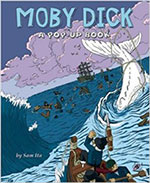

By James Dempsey
Worcester, MA, USA

James Dempsey
It just took me about five minutes to read my favorite story of all time, Moby-Dick.
I managed this prodigious feat by reading the work in what happens to be one of my most cherished literary forms—the pop-up book.
I picked up Sam Ita's Moby-Dick: A Pop-Up Book from the children's section of an arts and crafts store, where I was killing time as my wife searched for Christmas balls and decorations of a particular color and size.
What a bargain! On the first page alone I enjoyed a replica of the Pequod in dock, its decks clean and it sails neatly flooded, the nighttime meeting between Ishmael and the terrifying Queequeg, and Queequeg himself opening his hand to reveal the tiny figure of his deity, Yojo.
The wonders continued to unfold: Father Mapple delivering his blood-and-thunder sermon, a Bible that opened to reveal Jonah in the belly of the whale, sailors dancing and singing, the entrance of the fearsome Ahab, the first whale taken by the crew, the making of Queequeg's coffin, the dashing of the boat by the whale, the final rescue of the orphan Ishmael by the Rachel. This edition is something of a groundbreaker in that author Ita has blended pop-up artistry with elements of the graphic novel.

There is nothing like a pop-up book to get a child interested in literature. The word "interactive" is wildly overused these days, usually referring to the operation of a computer mouse, but the pop-up book is truly interactive, encouraging the child to grab a book, to move its pages, to operate the sweet little machinery of the pop-up art, and to be physically involved in a story in a way that neither a computer screen nor even a printed page could allow.
I never lost my love of the pop-up book. There is a magic to the act of turning the page of a pop-up book. As a reader, you have no idea what is going to happen on the next page and how the clever folding and pasting of paper will result in some unexpected sculptural delight, which often has working parts. This process is quite analogous to the act of reading itself when we first master it as children, experiencing the wonder of turning a page to see what happens next. What happens next. In three short words, the whole history of narrative art.
Moby-Dick is for me the greatest American novel, a blustering, shaggy, hugely ambitious rag-bag of a work that is full of adventure and philosophy. It describes the bloody and perilous work of killing whales in stupendous detail while at the same time following the thoughts of Ishmael, such a strange mixture of the dreamer and the adventurer, and the sheer bloody-minded overweening will of Ahab, who is often rightfully compared to the great Shakespearean characters. All this written in a style that hops from genre to genre and soars and swoops between registers like a frigate bird.
Link:
James Dempsey's Profile at Stay Thirsty Publishing





